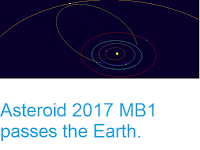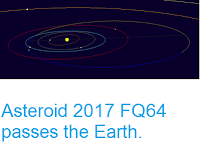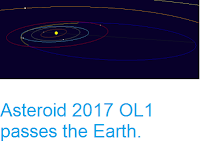Asteroid 2011 CC22 passed by the Earth at a distance of about 5 920 000
km (15.4 times the average distance between the Earth and the Moon, or 3.96% of the distance between the Earth and the Sun), slightly after 7.20
am
GMT on Friday 4 August 2017. There was no danger of
the asteroid hitting us, though were it to do so it would have
presented a significant threat. 2011 CC22 has an estimated
equivalent
diameter of 120-380 m (i.e. it is estimated that a spherical object
with
the same volume would be 120-360 m in diameter), and an object of this
size would be predicted to be capable of
passing through the Earth's
atmosphere relatively intact, impacting the ground directly with an
explosion that would be 60 000-1 500 000 times as powerful as the
Hiroshima
bomb. Such an impact would result in an impact crater about 4-5 km in
diameter
and devastation on a global scale, as well as climatic effects that
would last decades or even centuries.
The calculated orbit of 2011 CC22. Minor Planet Center.
2011 CC22 was discovered on 6 February 2011 by the
University of Arizona's Mt. Lemmon Survey at the Steward Observatory on Mount
Lemmon in the Catalina Mountains north of Tucson. The designation 2011 CC22
implies that the asteroid was the 1103rd object (object C22) discovered in the first half of February 2011 (period 2011 C).
2011 CC22 has a 434 day orbital period and an eccentric orbit tilted at an angle of 34.8° to the plane of the Solar System, which takes it from 0.99 AU from the Sun (i.e. 99% of he average distance at which the Earth orbits the Sun) to 1.25 AU from the Sun (i.e. 125% of the average distance at which the Earth orbits the Sun). It is therefore classed as an Apollo Group Asteroid (an asteroid that is on average further from the Sun than the Earth, but which does get closer). This means that close encounters between the asteroid and Earth are extremely common, with the last having occurred in February this year and the next predicted in July 2023. As an asteroid probably larger than 150 m in diameter that occasionally comes within 0.05 AU of the Earth, 2017 MB1 is also classified as a Potentially Hazardous Asteroid.
See also...







